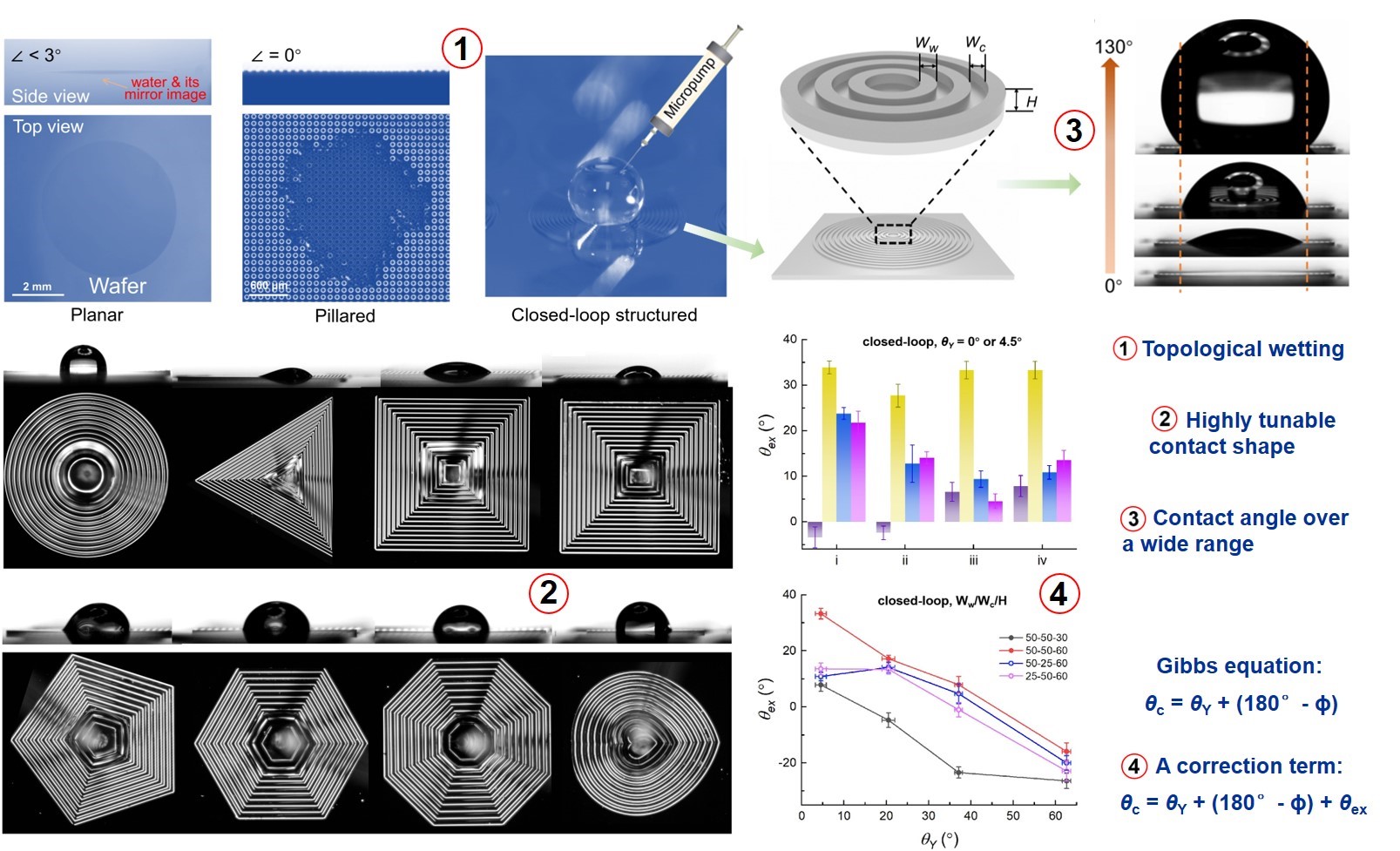Microdroplets find versatile applications in fields of chemistry, materials science and biochemistry, particularly in chemical engineering and biochemical microfluidics like microreactors and biosensors. Achieving precise control over microdroplets in their shape, size, and contact angle (CA) is especially crucial for applications like precise control of the printing/coating patterns and chemical reactions.
In a study published in Proceedings of the National Academy of Sciences of the United States of America(PNAS), Prof. GAO Yurui’s group from the National Center for Nanoscience and Technology (NCNST) of the Chinese Academy of Sciences (CAS), in collaboration with Prof. ZENG Xiaocheng from City University of Hong Kong and Prof. FRANCISCO Joseph S. from the University of Pennsylvania, have now employed photolithography techniques and subsequent processing to fabricate a class of structured surfaces featuring concentric closed-loop microwalls/microchannels. This approach allows for precise control of microdroplets with wide range of CAs, and high shape and pattern tunability.
Based on the notion of "topological wetting states", originally theoretically proposed in (J. Am. Chem. Soc. 2020, 142, 18491-18502), the research team successfully engineered a variety of surfaces with homocentric orthorhombic closed-loop microwalls/microchannels using lithography techniques. These surfaces exhibit precise microwall edge angles of 90° and, with the application of UV/ozone treatment, achieved an intrinsic contact angle of 0°. On these surfaces with closed-loop structures, topological wetting states were observed. Due to the closed-loop topology of the surface structures, the microdroplets exhibit multiple Wenzel states, with their three-phase contact lines pinned at the outer edge of the microwall and the CA can be varied widely from 0 to 130°. By designing the shape of homocentric microwalls, the microdroplet contact area and size can be effectively controlled as well, enabling formation not only regular shapes such as circles, triangles, squares, rectangles, pentagons, hexagons, octagons and dodecagons, but also of irregular patterns like heart-shaped shapes. Furthermore, they extended the control to the dimension of CA, proposing control across a broad range (from 0 to >130°), particularly for intrinsically completely wetting surface/liquid combinations, by leveraging droplet evaporation and the close-loop geometry.
“This work demonstrated closed-loop microstructures with well-controlled orthorhombic edges, enabling a comparative analysis of the droplet’s contact angle and the edge angle.” says Prof. GAO Yurui from NCNST, CAS.
Interestingly, the team uncovered a wetting phenomenon that challenges the traditional Gibbs equation in describing droplet at its boundaries: regardless of the shape of the closed-loop structure, the maximum CA of the microdroplet remains stable at around 130°, largely deviating from the angle limit predicted by the Gibbs equation based on macroscale edge effects. This result suggests that the Gibbs equation, traditionally used for accessing the CA of macrodroplets on rough surfaces, may not be applicable at the micro or nano scale, a conclusion applicable to various liquids, including isopropanol, ethanol, decane, and octane considered in this work. Moreover, through independent molecular dynamics simulations, the research team attributed this large deviation from Gibbs equation prediction to a cumulative effect of water-surface interaction and the atomic structure of the edge. The team also suggested adding a correction term to the Gibbs equation to address the apparent deviation.
“This work provides compiling evidence on the need for the modified Gibbs equation at the micro or nano scale. Additionally, obtaining droplets that can be precisely controlled offers a possibility for accurate measurement of droplets. This work has significant implications for exploiting controllable microdroplets in fields such as microfluidics, chemical reactions, and biosensing, thereby offering new opportunities for material manufacturing and green synthesis.” GAO Yurui says.

Highly tunable microdroplet closed-loop microstructured surfaces (Image by GAO Yurui et al)
Contact: GAO Yurui
National Center for Nanoscience and Technology (NCNST)
E-mail: gaoyr@nanoctr.cn




